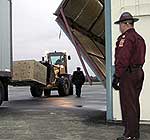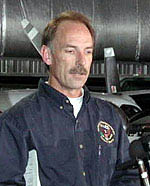By Bob Collins
Minnesota Public Radio
October 28, 2002
| |
|
|
|
||
An investigator for the National Transportation Safety Board says the on-scene inspection of the wreckage in which Sen. Paul Wellstone and seven others died on Friday is nearing an end.
Frank Hilldrup, Investigator in Charge for the NTSB, said investigators from the NTSB have removed several components of the aircraft and shipped them to various locations for further examination.
The Beech King Air A100 crashed and burned Friday about 2 1/2 miles from the Eveleth-Virginia Municipal Airport on northeastern Minnesota's Iron Range.
Among the unanswered questions are why the plane made a slow turn to the south, away from the airport, and why it descended at a steeper-than-normal angle, before it crashed into the heavily forested area.
"I don't know if the airplane was, in fact, turning at that point or not," Hilldrup said.
| |
|
|
|
||
The radar data showed the plane on a westerly heading shortly before the crash -- consistent with a normal approach to the runway. Over the weekend, NTSB Chair Carol Carmody revealed the plane appeared to be heading South as it crashed.
NTSB officials removed the larger pieces of the plane over the weekend, including the Pratt & Whitney turboprop engines. Most of what was left at the boggy site Monday was in small pieces, and investigators were sifting it carefully to make sure they missed nothing that could provide clues to what happened.
Investigators are also trying to determine if the weather - including icing conditions in the area - played a role. The plane had de-icing equipment and the NTSB is trying to determine if it was operating properly.
Hilldrup said an inspection of the plane indicated that the main landing gear of the aircraft was deployed although he said the damage was too great to determine if it was locked. He said the nose gear was destroyed. He said the plane's flaps - used to allow a plane to make a steep descent just before landing without picking up significant airspeed - appeared to be normally deployed.
| |
|
|
|
||
Hilldrup said he couldn't draw conclusions from the landing gear and flap position. But the findings could be significant in light of earlier suspicions that the plane was disabled by icing on the wing. A pilot struggling with a plane slowed by ice would try to eliminate sources of drag - including raising flaps and retracting landing gear.
Investigators say they want to check communications between other pilots flying in northern Minnesota on Friday to determine whether they experienced any icing problems.
Another pilot who took off from the same airport an hour after the accident experienced only "light icing" conditions.
As a matter of routine, the NTSB is also gathering toxicology reports and checking the background of both pilots.
Officials indicate it could be more than a year before a conclusion is reached in the investigation.
The Associated Press and MPR reporter Stephanie Hemphill contributed to this report.
More from MPR


